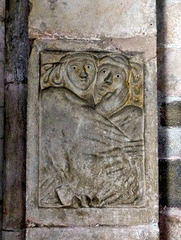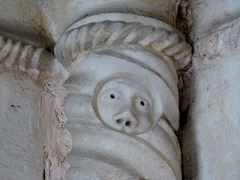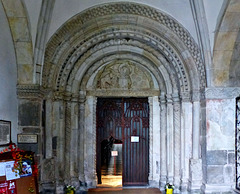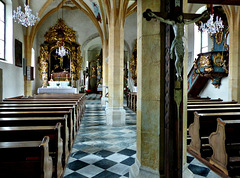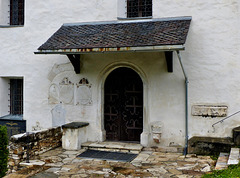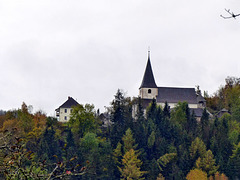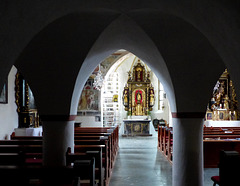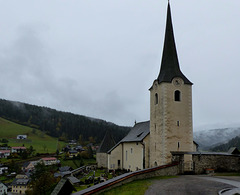Martin M. Miles' photos
Millstatt am See - Stift Millstatt
| |
|
|
|
Stift Millstatt ("Millstatt Abbey") was founded by the Aribo II and Boto, members of Aribonids, a noble, Bavarian family, around 1070.
Run by Benedictine monks and protected by Papal deeds Stift Millstatt prospered in the early years and a nunnery was added.
Within the 13th century, the decay began. As the abbey had secular Church Vogts, it suffered strongly under the political powergames of that timne and finaly ended 1456 under the House of Habsburg. At that time only 10 monks still lived here.
Emperor Frederick III reached a papal bull in 1469, so that the military order of the Knights of Saint George took over Stift Millstatt in order to fight the invading troops of the Ottoman Empire.
The order now had to cope with the debts left by the Benedictines and the redevelopment of the neglected premises. While the knights were engaged with the fortification of the monastery, they failed to protect the region. Millstatt was heavily devastated by the Turks in 1478, followed by Hungarian troops in 1487. As the power of the knightly order declined, unrests and revolts arose among the peasants.
As the new Protestant belief spread in the area the monastery vested the Society of Jesus ("Jesuits") in 1598 to support the Counter-Reformation.
The monks were disliked by the population for their stern measures. In 1737 the displeasure culminated in open revolt, when peasants ganged up and stormed the monastery. The rule of the Jesuits ended, when the order was suppressed by Pope Clement XIV in 1773. The monks had to leave Millstatt.
Today the former abbey-church serves the parish, while the other buildings belong to the Austrian state and host the "Österreichische Bundesforste" (Austrian State Forestry Commission).
The western side, the towers and the magnificent Romanesque funnel portal were created under abbot Heinrich I (1166 - 1177). The church underwent numerous alterations over the centuries. It did not only suffer from fires, but as well from earthquakes. A strong quake in 1690 heavily damaged the western facade. The repair took more than four years. The lintel under the tympanum at that time broke in four pieces (note the iron clamps). The Jesuits then covered the tympanum with plaster - and it stayed hidden until 1878.
These ladies are horrified by all the terrible beasts populating the narthex (previous uploads).
Millstatt am See - Stift Millstatt
| |
|
|
|
Stift Millstatt ("Millstatt Abbey") was founded by the Aribo II and Boto, members of Aribonids, a noble, Bavarian family, around 1070.
Run by Benedictine monks and protected by Papal deeds Stift Millstatt prospered in the early years and a nunnery was added.
Within the 13th century, the decay began. As the abbey had secular Church Vogts, it suffered strongly under the political powergames of that timne and finaly ended 1456 under the House of Habsburg. At that time only 10 monks still lived here.
Emperor Frederick III reached a papal bull in 1469, so that the military order of the Knights of Saint George took over Stift Millstatt in order to fight the invading troops of the Ottoman Empire.
The order now had to cope with the debts left by the Benedictines and the redevelopment of the neglected premises. While the knights were engaged with the fortification of the monastery, they failed to protect the region. Millstatt was heavily devastated by the Turks in 1478, followed by Hungarian troops in 1487. As the power of the knightly order declined, unrests and revolts arose among the surrounding peasants.
As the new Protestant belief spread in the area the monastery vested the Society of Jesus ("Jesuits") in 1598 to support the Counter-Reformation.
The monks were disliked by the population for their stern measures. In 1737 the displeasure culminated in open revolt, when peasants ganged up and stormed the monastery. The rule of the Jesuits ended, when the order was suppressed by Pope Clement XIV in 1773. The monks had to leave Millstatt.
Today the former abbey-church serves the parish, while the other buildings belong to the Austrian state and host the "Österreichische Bundesforste" (Austrian State Forestry Commission).
The western side, the towers and the magnificent Romanesque funnel portal were created under abbot Heinrich I (1166 - 1177). The church underwent numerous alterations over the centuries. It did not only suffer from fires, but as well from earthquakes. A strong quake in 1690 heavily damaged the western facade. The repair took more than four years. The lintel under the tympanum at that time broke in four pieces (note the iron clamps). The Jesuits then covered the tympanum with plaster - and it stayed hidden until 1878.
The masters working on the facade had some very strange ideas. I have seen many pillar-eaters. Here is somebody who is locked inside a pillar. Come in - and look out!
Millstatt am See - Stift Millstatt
| |
|
|
Stift Millstatt ("Millstatt Abbey") was founded by the Aribo II and Boto, members of Aribonids, a noble, Bavarian family, around 1070.
Run by Benedictine monks and protected by Papal deeds Stift Millstatt prospered in the early years and a nunnery was added.
Within the 13th century, the decay began. As the abbey had secular Church Vogts, it suffered strongly under the political powergames of that timne and finaly ended 1456 under the House of Habsburg. At that time only 10 monks still lived here.
Emperor Frederick III reached a papal bull in 1469, so that the military order of the Knights of Saint George took over Stift Millstatt in order to fight the invading troops of the Ottoman Empire.
The order now had to cope with the debts left by the Benedictines and the redevelopment of the neglected premises. While the knights were engaged with the fortification of the monastery, they failed to protect the region. Millstatt was heavily devastated by the Turks in 1478, followed by Hungarian troops in 1487. As the power of the knightly order declined, unrests and revolts arose among the surrounding peasants.
As the new Protestant belief spread in the area the monastery vested the Society of Jesus ("Jesuits") in 1598 to support the Counter-Reformation.
The monks were disliked by the population for their stern measures. In 1737 the displeasure culminated in open revolt, when peasants ganged up and stormed the monastery. The rule of the Jesuits ended, when the order was suppressed by Pope Clement XIV in 1773. The monks had to leave Millstatt.
Today the former abbey-church serves the parish, while the other buildings belong to the Austrian state and host the "Österreichische Bundesforste" (Austrian State Forestry Commission).
The western side, the towers and the magnificent Romanesque funnel portal were created under abbot Heinrich I (1166 - 1177). The church underwent numerous alterations over the centuries. It did not only suffer from fires, but as well from earthquakes. A strong quake in 1690 heavily damaged the western facade. The repair took more than four years. The lintel under the tympanum at that time broke in four pieces (note the iron clamps). The Jesuits then covered the tympanum with plaster - and it stayed hidden until 1878.
The masters working on the facade had some very strange ideas. I have seen many pillar-eaters. Here is somebody who looks out of a pillar. Come in - and look out!
Millstatt am See - Stift Millstatt
| |
|
Stift Millstatt ("Millstatt Abbey") was founded by the Aribo II and Boto, members of Aribonids, a noble, Bavarian family, around 1070.
Run by Benedictine monks and protected by Papal deeds Stift Millstatt prospered in the early years and a nunnery was added.
Within the 13th century, the decay began. As the abbey had secular Church Vogts, it suffered strongly under the political powergames of that timne and finaly ended 1456 under the House of Habsburg. At that time only 10 monks still lived here.
Emperor Frederick III reached a papal bull in 1469, so that the military order of the Knights of Saint George took over Stift Millstatt in order to fight the invading troops of the Ottoman Empire.
The order now had to cope with the debts left by the Benedictines and the redevelopment of the neglected premises. While the knights were engaged with the fortification of the monastery, they failed to protect the region. Millstatt was heavily devastated by the Turks in 1478, followed by Hungarian troops in 1487. As the power of the knightly order declined, unrests and revolts arose among the surrounding peasants.
As the new Protestant belief spread in the area the monastery vested the Society of Jesus ("Jesuits") in 1598 to support the Counter-Reformation.
The monks were disliked by the population for their stern measures. In 1737 the displeasure culminated in open revolt, when peasants ganged up and stormed the monastery. The rule of the Jesuits ended, when the order was suppressed by Pope Clement XIV in 1773. The monks had to leave Millstatt.
Today the former abbey-church serves the parish, while the other buildings belong to the Austrian state and host the "Österreichische Bundesforste" (Austrian State Forestry Commission).
The western side, the towers and the magnificent Romanesque funnel portal were created under abbot Heinrich I (1166 - 1177). The church underwent numerous alterations over the centuries. It did not only suffer from fires, but as well from earthquakes. A strong quake in 1690 heavily damaged the western facade. The repair took more than four years. The lintel under the tympanum at that time broke in four pieces (note the iron clamps). The Jesuits then covered the tympanum with plaster - and it stayed hidden until 1878.
The right side of the funnel portal reminds me on carvings I have seen on wooden posts of "marae", Maori-houses in New Zealand. The face in the center - could be a Maori with a face-tatoo (moko). But, when this face was carved (~ 1170) the Maori had probably not reached "Aotearoa".
Millstatt am See - Stift Millstatt
| |
|
Stift Millstatt ("Millstatt Abbey") was founded by the Aribo II and Boto, members of Aribonids, a noble, Bavarian family, around 1070.
Run by Benedictine monks and protected by Papal deeds Stift Millstatt prospered in the early years and a nunnery was added.
Within the 13th century, the decay began. As the abbey had secular Church Vogts, it suffered strongly under the political powergames of that timne and finaly ended 1456 under the House of Habsburg. At that time only 10 monks still lived here.
Emperor Frederick III reached a papal bull in 1469, so that the military order of the Knights of Saint George took over Stift Millstatt in order to fight the invading troops of the Ottoman Empire.
The order now had to cope with the debts left by the Benedictines and the redevelopment of the neglected premises. While the knights were engaged with the fortification of the monastery, they failed to protect the region. Millstatt was heavily devastated by the Turks in 1478, followed by Hungarian troops in 1487. As the power of the knightly order declined, unrests and revolts arose among the surrounding peasants.
As the new Protestant belief spread in the area the monastery vested the Society of Jesus ("Jesuits") in 1598 to support the Counter-Reformation.
The monks were disliked by the population for their stern measures. In 1737 the displeasure culminated in open revolt, when peasants ganged up and stormed the monastery. The rule of the Jesuits ended, when the order was suppressed by Pope Clement XIV in 1773. The monks had to leave Millstatt.
Today the former abbey-church serves the parish, while the other buildings belong to the Austrian state and host the "Österreichische Bundesforste" (Austrian State Forestry Commission).
The western side, the towers and the magnificent Romanesque funnel portal were created under abbot Heinrich I (1166 - 1177). The church underwent numerous alterations over the centuries. It did not only suffer from fires, but as well from earthquakes. A strong quake in 1690 heavily damaged the western facade. The repair took more than four years. The lintel under the tympanum at that time broke in four pieces (note the iron clamps). The Jesuits then covered the tympanum with plaster - and it stayed hidden until 1878.
This is the base of one of the side pillars. Depicted is a cripple who moves in using crutches. There is something "behind" the young man (?). Are there beasts/dragons on his shoulders. Are more cripples behind him. There seems to be a rope around his stomach..
Millstatt am See - Stift Millstatt
| |
|
|
|
Stift Millstatt ("Millstatt Abbey") was founded by the Aribo II and Boto, members of Aribonids, a noble, Bavarian family, around 1070.
Run by Benedictine monks and protected by Papal deeds Stift Millstatt prospered in the early years and a nunnery was added.
Within the 13th century, the decay began. As the abbey had secular Church Vogts, it suffered strongly under the political powergames of that timne and finaly ended 1456 under the House of Habsburg. At that time only 10 monks still lived here.
Emperor Frederick III reached a papal bull in 1469, so that the military order of the Knights of Saint George took over Stift Millstatt in order to fight the invading troops of the Ottoman Empire.
The order now had to cope with the debts left by the Benedictines and the redevelopment of the neglected premises. While the knights were engaged with the fortification of the monastery, they failed to protect the region. Millstatt was heavily devastated by the Turks in 1478, followed by Hungarian troops in 1487. As the power of the knightly order declined, unrests and revolts arose among the surrounding peasants.
As the new Protestant belief spread in the area the monastery vested the Society of Jesus ("Jesuits") in 1598 to support the Counter-Reformation.
The monks were disliked by the population for their stern measures. In 1737 the displeasure culminated in open revolt, when peasants ganged up and stormed the monastery. The rule of the Jesuits ended, when the order was suppressed by Pope Clement XIV in 1773. The monks had to leave Millstatt.
Today the former abbey-church serves the parish, while the other buildings belong to the Austrian state and host the "Österreichische Bundesforste" (Austrian State Forestry Commission).
The western side, the towers and the magnificent Romanesque funnel portal were created under abbot Heinrich I (1166 - 1177). The church underwent numerous alterations over the centuries. It did not only suffer from fires, but as well from earthquakes. A strong quake in 1690 heavily damaged the western facade. The repair took more than four years. The lintel under the tympanum at that time broke in four pieces (note the iron clamps). The Jesuits then covered the tympanum with plaster - and it stayed hidden until 1878.
The tympanum depicts Christ Pantocrator (same hairdo like Samson in Gurk!), holding a book ("Ego sum Alpha et Omega") and surrounded by sun, moon and stars. Christ blesses Abbot Henricus, who holds a model of the church.
The inscription on the archivolt reads "HEINRICUS ABBAS RUDGER - - - E FECIT! It is incomplete, but it is clear that Rudger (the artist) signed his work.
Millstatt am See - Stift Millstatt
| |
|
|
|
Stift Millstatt ("Millstatt Abbey") was founded by the Aribo II and Boto, members of Aribonids, a noble, Bavarian family, around 1070.
Run by Benedictine monks, who surely had contacts to Hirsau (-> Cluny) and protected by Papal deeds, Stift Millstatt prospered in the early years and a nunnery wa added.
Within the 13th century, the decay began. As the abbey had secular Church Vogts, it suffered strongly under the political powergames of that timne and finaly ended 1456 under the House of Habsburg. At that time only 10 monks still lived here.
Emperor Frederick III reached a papal bull in 1469, so that the military order of the Knights of Saint George took over Stift Millstatt in order to fight the invading troops of the Ottoman Empire.
The order now had to cope with the debts left by the Benedictines and the redevelopment of the neglected premises. While the knights were engaged with the fortification of the monastery, they failed to protect the region. Millstatt was heavily devastated by the Turks in 1478, followed by Hungarian troops in 1487. As the power of the knightly order declined, unrests and revolts arose among the surrounding peasants.
As the new Protestant belief spread in the area the monastery vested the Society of Jesus ("Jesuits") in 1598 to support the Counter-Reformation.
The monks were disliked by the population for their stern measures. In 1737 the displeasure culminated in open revolt, when peasants ganged up and stormed the monastery. The rule of the Jesuits ended, when the order was suppressed by Pope Clement XIV in 1773. The monks had to leave Millstatt.
Today the former abbey-church serves the parish, while the other buildings, that had passed to the public administration of the Habsburg Monarchy, when the Jesuits left, belong to the Austrian state and host the "Österreichische Bundesforste" (Austrian State Forestry Commission).
The church underwent numerous alterations over the centuries. The western side, the towers and this this magnificent Romanesque funnel portal were created under abbot Heinrich I (1166 - 1177). The carvings of the portal have a very specific style.
Millstatt am See - Stift Millstatt
| |
|
|
Stift Millstatt ("Millstatt Abbey") was founded by the Aribo II and Boto, members of Aribonids, a noble, Bavarian family, around 1070.
Run by Benedictine monks, who surely had contacts to Hirsau (-> Cluny) and protected by Papal deeds, Stift Millstatt prospered in the early years and a nunnery wa added.
Within the 13th century, the decay began. As the abbey had secular Church Vogts, it suffered strongly under the political powergames of that timne and finaly ended 1456 under the House of Habsburg. At that time only 10 monks still lived here.
Emperor Frederick III reached a papal bull in 1469, so that the military order of the Knights of Saint George took over Stift Millstatt in order to fight the invading troops of the Ottoman Empire.
The order now had to cope with the debts left by the Benedictines and the redevelopment of the neglected premises. While the knights were engaged with the fortification of the monastery, they failed to protect the region. Millstatt was heavily devastated by the Turks in 1478, followed by Hungarian troops in 1487. As the power of the knightly order declined, unrests and revolts arose among the surrounding peasants.
As the new Protestant belief spread in the area the monastery vested the Society of Jesus ("Jesuits") in 1598 to support the Counter-Reformation.
The monks were disliked by the population for their stern measures. In 1737 the displeasure culminated in open revolt, when peasants ganged up and stormed the monastery. The rule of the Jesuits ended, when the order was suppressed by Pope Clement XIV in 1773. The monks had to leave Millstatt.
Today the former abbey-church serves the parish, while the other buildings, that had passed to the public administration of the Habsburg Monarchy, when the Jesuits left, belong to the Austrian state and host the "Österreichische Bundesforste" (Austrian State Forestry Commission).
Tiffen - St. Jakobus
| |
|
A church, overlooking the valley, existed on the promontory since about 1050. The church seen here was erected within the 12 century, but later got strong Gothic and Baroque enlargements and alterations.
In Gothic times a second nave was added to the once Romanesque church, so by now this is a "two-nave -church", where the row of pillars is in the center of the church.
Tiffen - St. Jakobus
| |
|
A church, overlooking the valley, existed on the promontory since about 1050. The church seen here was erected within the 12 century, but later got strong Gothic and Baroque enlargements and alterations.
The church and the surrounding area got fortified in the 15th century, during the times of the Turkish and Magyar incursions.
Where the first church was built around 1000 had once been a Celtic place of worship and later a Roman temple of Jupiter. So it is no surprise that some Roman reliefs decorate the outside walls. Here is one just over the handrail.
Tiffen - St. Jakobus
| |
|
A church, overlooking the valley, existed on the promontory since about 1050. The church seen here was erected, where once a Roman temple had been, within the 12 century, but later got strong Gothic and Baroque enlargements and alterations.
The church and the surrounding area got fortified in the 15th century, during the times of the Turkish and Magyar incursions. It is still surounded by walls and protected by a Karner (ossuary) that served as a defense tower. It occupies the highest point of the protected territory, what is the graveyard today.
Tiffen - St. Jakobus
| |
|
A church, overlooking the valley, existed on the promontory since about 1050. The church seen here was erected, where once a Roman temple had been, within the 12 century, but later got strong Gothic and Baroque enlargements and alterations.
The church and the surrounding area got fortified in the 15th century, during the times of the Turkish and Magyar incursions. It is still surounded by walls and protected by a Karner (ossuary) that served as a defense tower.
Deutsch-Griffen - St. Jakobus
| |
|
Hemma of Gurk donated a chapel in "Grivinne" in 1043. The chapel belonged to the chapter of the Gurk cathedral in 1157 and around 1218 was the parish church Deutsch-Griffen.
The Romanesque structure was rebuilt as a fortified church in the 15th century, when it served as a refuge for the villagers during the Turkish incursions. Since then it is surounded by a wall. The octagonal Karner (ossuary) erected in the 14th century was used as a defense tower duirng that time.
The Karner is dedicated to Saint Oswald (of Northumbria). The basement is still full of human bones.
Deutsch-Griffen - St. Jakobus
| |
|
Hemma of Gurk donated a chapel in "Grivinne" in 1043. The chapel belonged to the chapter of the Gurk cathedral in 1157 and around 1218 was the parish church Deutsch-Griffen.
The Romanesque structure was rebuilt as a fortified church in the 15th century, when it served as a refuge for the villagers during the Turkish incursions. Since then it is surounded by a wall. The Karner (ossuary) erected in the 14th century was used as a defense tower duirng that time.
Inside the church are some extraordinary frescoes, that were "re-discovered" under plaster in 1928. Most of them were created by a studio named "Villacher Schule", that existed from around 1440.
Some in a bad state conditions. The conservationist is working with painstaking care inside the freezing cold church. A hard job! Thank you!!
Deutsch-Griffen - St. Jakobus
| |
|
|
|
Hemma of Gurk donated a chapel in "Grivinne" in 1043. The chapel belonged to the chapter of the Gurk cathedral in 1157 and around 1218 was the parish church Deutsch-Griffen.
The Romanesque structure was rebuilt as a fortified church in the 15th century, when it served as a refuge for the villagers during the Turkish incursions. Since then it is surounded by a wall. The Karner (ossuary) erected in the 14th century was used as a defense tower duirng that time.
Inside the church are some extraordinary frescoes, that were "re-discovered" under plaster in 1928. Most of them were created by a studio named "Villacher Schule", that existed from around 1440.
Some in a bad state conditions.
A conservationist was working inside the freezing cold church and allowed us to enter.
Deutsch-Griffen - St. Jakobus
| |
|
Hemma of Gurk donated a chapel in "Grivinne" in 1043. The chapel belonged to the chapter of the Gurk cathedral in 1157 and around 1218 was the parish church Deutsch-Griffen.
The Romanesque structure was rebuilt as a fortified church in the 15th century, when it served as a refuge for the villagers during the Turkish incursions. Since then it is surounded by a wall. The Karner (ossuary) erected in the 14th century was used as a defense tower duirng that time.
Inside the church are some extraordinary frescoes, some in a bad state conditions. A conservationist was working inside and allowed us to enter.
Deutsch-Griffen - St. Jakobus
| |
|
|
Hemma of Gurk donated a chapel in "Grivinne" in 1043. The chapel belonged to the chapter of the Gurk cathedral in 1157 and around 1218 was the parish church Deutsch-Griffen.
The Romanesque structure was rebuilt as a fortified church in the 15th century, when it served as a refuge for the villagers during the Turkish incursions. Since then it is surounded by a wall. The Karner (ossuary) erected in the 14th century was used as a defense tower duirng that time.
Deutsch-Griffen - St. Jakobus
| |
|
|
|
Hemma of Gurk donated a chapel in "Grivinne" in 1043. The chapel belonged to the chapter of the Gurk cathedral in 1157 and around 1218 was the parish church Deutsch-Griffen.
The Romanesque structure was rebuilt as a fortified church in the 15th century, when it served as a refuge for the villagers during the Turkish incursions. Since then it is surounded by a strong wall. The Karner (ossuary) erected in the 14th century was used as a defense tower duirng that time.
Since 1755 church and churchyard are "connected" with the village in the vallye by a roofed stair with 178 steps.
Jump to top
- ipernity © 2007-2024
- Help & Contact
|
Club news
|
About ipernity
|
History |
ipernity Club & Prices |
Guide of good conduct
Donate | Group guidelines | Privacy policy | Terms of use | Statutes | In memoria -
Facebook
Twitter

